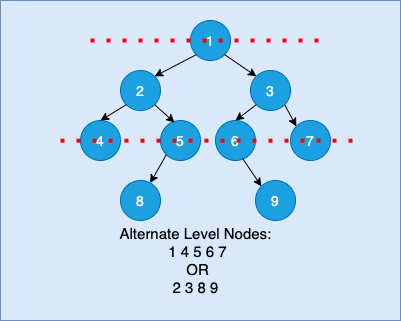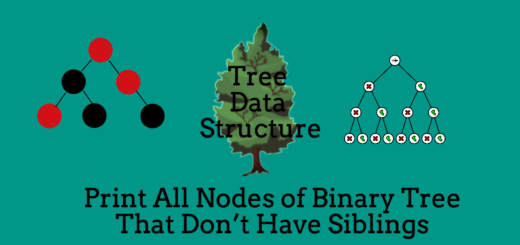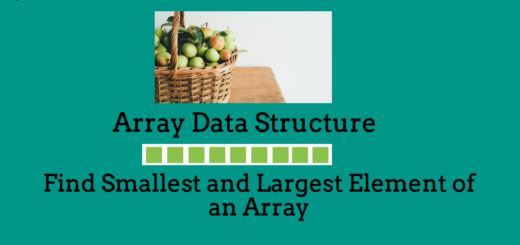Print Alternate Levels of a Binary Tree
“Print Alternate Levels of a Binary Tree” is a simple modification of level order tree traversal algorithm. Here, we are given a Binary Tree and our task is to write a program to print alternate levels of a Binary Tree.

Again, we can solve this problem using previous discussed two methods.
Method 1: Brute-Force Approach
The simplest solution to print alternate level order tree traversal is to traverse and print the nodes at level 1, then traverse and print the nodes at level 3 and so on; till all the alternate level nodes are not traversed and printed.
C++ Program to Print Alternate Levels of a Binary Tree is as follows:
/* C++ Program to Print Alternate Level of a Binary Tree*/
#include<bits/stdc++.h>
using namespace std;
typedef struct Node
{
int data;
struct Node *left;
struct Node *right;
Node(int ele)
{
data = ele;
left = NULL;
right = NULL;
}
} Node;
/* Function to Compute height of a Binary Tree */
int height(Node *root)
{
/* If tree is empty, height will be 0 */
if(root == NULL)
{
return 0;
}
else
{
/* Compute Height of Left Subtree */
int leftHeight = height(root -> left);
/* Compute Height of Right Subtree */
int rightHeight = height(root -> right);
/* Return max of height of subtree and right subtree + 1 */
return max(leftHeight,rightHeight) + 1;
}
}
/* Function to Print Nodes of a Particular Level */
void printLevel(Node *root, int level)
{
if(root == NULL)
return;
if(level == 1)
cout<<root -> data<< " ";
else if(level > 1)
{
printLevel(root -> left,level-1);
printLevel(root -> right, level-1);
}
}
/* Function to Print Alternate Level of a Binary Tree */
void printAlternate(Node *root)
{
/* Basic Test Case Scenerio */
if(root == NULL)
return;
/* Compute Height and print Level by Level */
int h = height(root);
for(int i = 1; i <= h; i=i+2)
printLevel(root,i);
}
int main()
{
/* Creating a Binary tree and inserting some nodes in it */
Node *root = NULL;
root = new Node(1);
root -> left = new Node(2);
root -> right = new Node(3);
root -> left -> left = new Node(4);
root -> left -> right = new Node(5);
root -> right -> left = new Node(6);
root -> right -> right = new Node (7);
root -> left -> right -> left = new Node(8);
root -> right -> left -> right = new Node(9);
/* Calling function to Print Alternate Level of a Binary Tree */
cout<<"The Nodes at Alternate Levels of the Given Binary Tree :\n";
printAlternate(root);
}
OUTPUT:
The Nodes at Alternate Levels of the Given Binary Tree : 1 4 5 6 7
Method 2: Using Queue
The steps required to print alternate levels of Binary Tree are as follows:
- Create two queues: que1 and que2.
- Push root node into que1.
- Until both queues are not empty, perform following steps:
- Until que1 is not empty, perform following steps:
- Print Front node of que1.
- If left child of front node exists, then, push left child into que2.
- If right child of front node exists, then, push right child into que2.
- Pop out front node.
- Until que2 is not empty, perform following steps:
- If left child of front node exists, then, push left child into que1.
- If right child of front node exists, then, push right child into que1.
- Pop out front node.
- Until que1 is not empty, perform following steps:
C++ Program to print alternate levels of Binary Tree is as follows:
/* C++ Program to Print Alternate Level of Binary Tree */
#include<bits/stdc++.h>
using namespace std;
typedef struct Node
{
int data;
struct Node *left;
struct Node *right;
Node(int ele)
{
data = ele;
left = NULL;
right = NULL;
}
} Node;
/* Function to Print Alternate Level of Binary Tree*/
void printAlternate(Node *root)
{
/* Basic Test Case Scenerio */
if(root == NULL)
return;
queue <Node*> que1;
queue <Node*> que2;
que1.push(root);
while(!que1.empty() || !que2.empty())
{
while(!que1.empty())
{
Node *temp = que1.front();
cout<<temp->data<<" ";
if(temp -> left)
que2.push(temp -> left);
if(temp -> right)
que2.push(temp -> right);
que1.pop();
}
while(!que2.empty())
{
Node *temp = que2.front();
if(temp -> left)
que1.push(temp -> left);
if(temp -> right)
que1.push(temp -> right);
que2.pop();
}
}
}
int main()
{
/* Creating a Binary tree and inserting some nodes in it */
Node *root = NULL;
root = new Node(1);
root -> left = new Node(2);
root -> right = new Node(3);
root -> left -> left = new Node(4);
root -> left -> right = new Node(5);
root -> right -> left = new Node(6);
root -> right -> right = new Node (7);
root -> left -> right -> left = new Node(8);
root -> right -> left -> right = new Node(9);
/* Calling function for Level Order Traversal */
cout<<"The Alternate Levels of Given Binary Tree are:\n";
printAlternate(root);
}
OUTPUT:
The Alternate Levels of Given Binary Tree are: 1 4 5 6 7
Related Posts:
- Introduction to Tree Data Structure
- Binary Tree Traversals
- Print All Leaf Nodes of a Binary Tree
- Count Number of Nodes in a Binary Tree
- Maximum Width of Binary Tree
- Level Order Tree Traversal
- Left View of Binary Tree
- Right View of Binary Tree
- Compute Height of Binary Tree
- Inorder Tree Traversal Using Stack
- Preorder Tree Trasversal Using Stack
- Postorder Tree Traversal Using Stack
- Vertical Order Tree Traversal
- Top View of Binary Tree
- Bottom View of Binary Tree
- Delete Complete Binary Tree
- Check if two trees are mirror Trees of Each Other
- Convert Binary Tree to its Mirror Tree
- Check if Binary Tree is Symmetric or Not
- Print All Root to Leaf Paths in a Binary Tree


